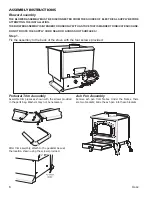
13
5 WARNINGS AND MAINTENANCE
All maintenance operations (cleaning, potential replacements, etc.) must be carried out when the fire is out
and the hot spot is cold. In addition, do not use any abrasive substances.
Caution: failure to clean affects safety
5.1 Opening the door
The burner door must remain closed during operation. The door should be opened only with the hot spot off
and cooled down to perform maintenance and routine cleaning.
5.2 Disposal of ashes
The ash collection compartment must be emptied regularly so as to impede combustion residue from arriving
at the brazier support. Ashes must be placed in a metal container with a sealed lid. Until ashes are completely
out, the sealed container should be placed on a non-combustible base or on the floor, or well away from
flammable materials.
CAUTION: ashes keep embers on for a long time
5.3 Brazier cleaning
When the flame becomes red or is weak accompanied by black smoke, it may mean that there are ash
deposits or incrustations which are not allowing correct hot spot operation and which must be removed.
To perform periodical cleaning, remove the brazier by releasing it from the shaker and lifting it from its
housing; then clean it of ash and any incrustations which could have formed, with particular attention to
freeing clogged holes using a pointed tool.
This operation is necessary in particular the first few ignitions, especially when using different quality pellets.
The timing of this operation is determined by the frequency of use and the choice of fuel.
It is advisable to also check the brazier support, emptying it of any ashes.
CAUTION: before turning the
hot spot on, check that the brazier is correctly inserted, resting against the rear wall of the
combustion chamber and hooked to the shaker and clean and free of ashes.
5.4 Ash drawer cleaning
Periodically check (about every 6 hours of operation) the ash drawer through the special inspection glass.
And empty it at the end of each use through the door handle.
See paragraph 5.2 for ash disposal.
Fig. 18
Fig. 19


































